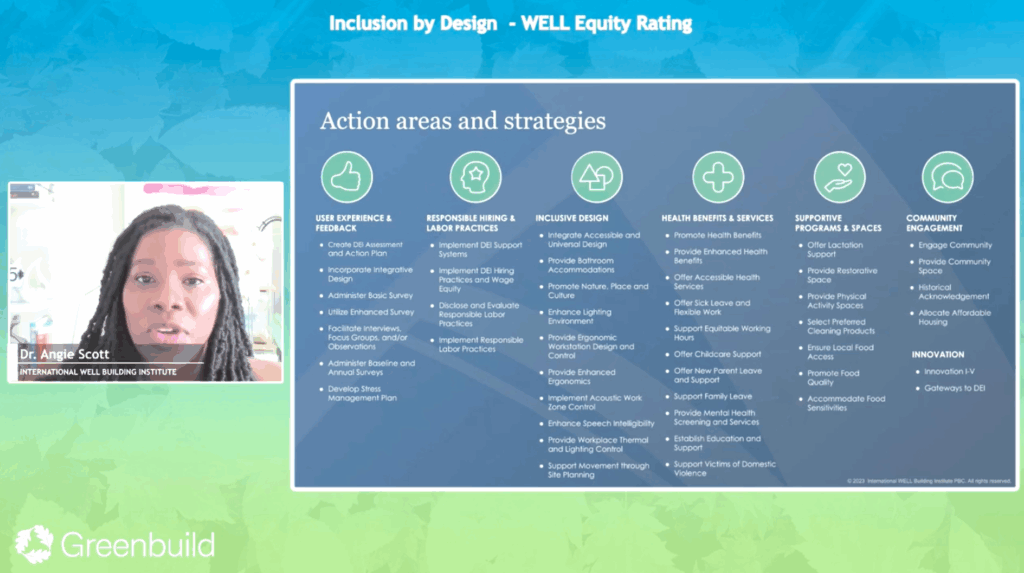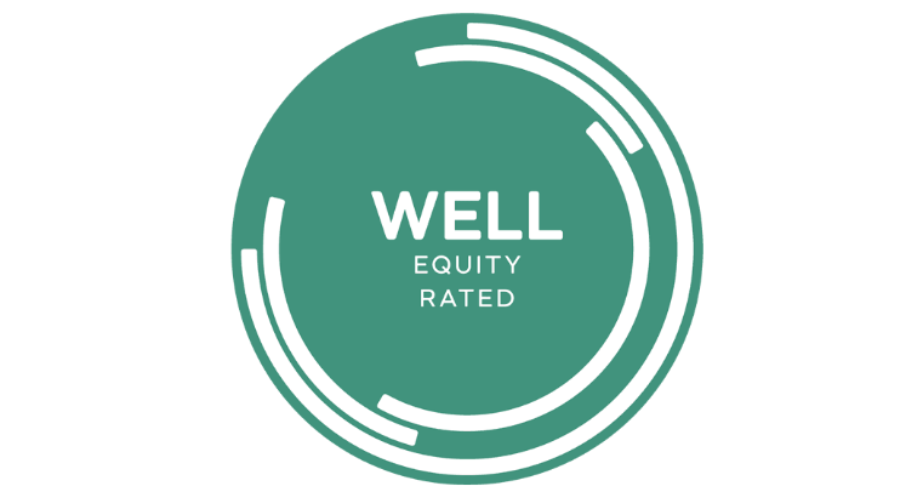Designing for US: The WELL Equity Rating
Following the COVID-19 pandemic, and with workforce demographics rapidly shifting, a greater emphasis is being placed on the spaces we work and the policies enforced. Workplace culture has become a more important tool than ever before when it comes to recruiting and retaining staff.
Following the COVID-19 pandemic, and with workforce demographics rapidly shifting, a greater emphasis is being placed on the spaces we work and the policies enforced. Workplace culture has become a more important tool than ever before when it comes to recruiting and retaining staff.
In February 2024, Greenbuild and the International WELL Building Institute hosted a webinar highlighting how focusing attention toward the diverse needs of employees in the workplace can better set them up for success, and that everyone benefits when design takes the needs of all users into account.
In this webinar, speakers Whitney Austin Gray and Angie Scott from IWBI introduced us to the WELL Equity Rating and demonstrated how implementing and achieving these strategies can support DEI goals, create a sustainable and thriving workplace culture, and show the potential for ROI when designing inclusively.
“ Too often we hear that certain features are made for certain populations or certain people – so that is a design for ‘them’ but there is so much to unpack that can benefit and include everyone. ”
Dr. Whitney Austin Gray, International WELL Building Institute
What It Means to Be WELL
The WELL Building Standard, backed by the most up-to-date research, serves as a guidepost for buildings and organizations looking to achieve spaces that enhance human health and well-being. WELL operates under the understanding that people are our most valuable resource and that buildings can play a critical role in helping (rather than hindering) human health.

Introducing the WELL Equity Rating
The WELL Equity Rating (WER) is a set of evidence-based strategies from the WELL standard for taking action specifically toward DEI and accessibility goals and driving improvements in company culture and employee health. The WER is applicable to organizations of all sizes and can be applied at a single location or across multiple locations.
By conducting extensive external engagement including co-chair interviews, advisory convenings, roundtables, surveys, webcasts, and even a hip hop architecture camp to tap into the thoughts of younger generations, IWBI was able to identify problems and solutions in the workplace from the people who would be impacted the most in order to co-create the WELL Equity Rating before bringing it to market.
Steps to achieving the WELL Equity Rating include 43 different strategies in 7 different action areas to help unpack how an organization can be inclusive for all and implementing design and policy that allows everyone to thrive. Organizations pursuing the WELL Equity Rating must meet at least 21 of the 43 strategies in order to receive the WER Seal, however obtaining the WER is made more accessible by allowing for additional pathways to certification, such as substituting a WELL Building Standard credit if the organization is able to show how that strategy supports one of the Action Areas on the WER Scorecard.
WELL Equity Rating also calls for action, accountability and innovation by requiring annual renewal of the WER certification.
Action Areas
- User Experience & Feedback
- Responsible Hiring & Labor Practices
- Inclusive Design
- Health Benefits & Services
- Supportive Programs and Spaces
- Community Engagement
- Innovation

It is also worth noting that there is flexibility in the approach you take when pursuing the WELL Equity Rating, depending on the phase of your project. This flexibility allows for pre-construction or projects under construction to focus on design-based features, while projects that are well underway or post construction have the ability to focus their attention on policy-based features of the WER.
The WELL Equity Rating encourages policy and design that benefit all – and not always just who you first expect:
WER EB06: Health Benefits/Services: Offer Childcare Support
- On-site daycare
- Backup daycare options
- Policies to support flexible work for parents.
Your initial thought might be that this policy is solely for mothers of young children, but this is just one example of a policy that can benefit an entire organization. Mothers as well as fathers or other primary caregivers can benefit from the comfort of knowing there are options available during school breaks, weather advisories or other emergencies, or other situations when childcare is not available.
WER ES2: Supportive Programs + Spaces: Provide Restorative Space
- Create a calming space for relaxation and restoration by providing:
- Adjustable lighting
- Sound interventions
- Thermal control
- Seating arrangements
- Subdued colors
- Visual privacy
This feature speaks specifically to design strategy and requires environments that encourage use of the restoration space as it was intended. Again, this is a feature that was maybe designed with a particular community of individuals in mind, such as members of the neurodiverse community, but can be beneficial to everyone.
“ When we look at humans globally, we are over 99% similar biologically, but the places that we live in, and the cultures that we are a part of differ, our history and backgrounds differ. How we use design and policy, strategies and operational strategies, to impact the role of buildings to make us healthy, to be more inclusive, and to be more welcoming and accessible for all is so critical. ”
Dr. Whitney Austin Gray
International WELL Building Institute
Why WELL Equity?
The WELL Equity Rating serves as a roadmap to create protocols that can give everyone the opportunity to thrive and will continue to evolve as new data becomes available. However, we already have a pretty good idea of the impact implementing these strategies can have on the workplace.
DEI strategies, accessibility considerations, and workplace culture are imperative to high-performing organizations, especially when it comes to recruitment and retention. As we heard in the Inclusion By Design Webinar, 76% of candidates seek out a diverse organizations during their job searches, and organizational culture and alignment with personal values and social issues is a top consideration for over 75% of job candidates. We also learned that disability-inclusive business strategy promises a significant return on investment including higher revenue, higher net income, higher profit margins and stronger next-generation talent acquisition and retention.
It is clear that an organization’s attention to DEI and employee health and well-being are an important part of job satisfaction and more comfortable and productive workspaces. By studying and including the most underrepresented, marginalized, or otherwise “invisible” populations and communities in design and policy, we can unlock answers and solutions that work for everyone.
Resources
Visit the WELL Equity Rating Landing Page for access to detailed program resources including the latest WELL Equity Rating, sample scorecard, alignment tools, gap analysis tool, and more.
You can also access the WELL Forum ( with free and premium versions available) for access to a continued open discourse surrounding WELL.
Finally, the International WELL Building Institute’s annual conference is being hosted in Long Beach, CA from May 7 through May 9. Learn more and get tickets on the WELL website!

